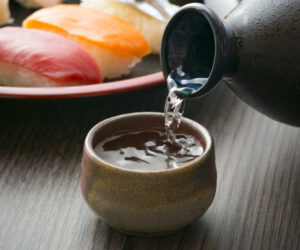For most Americans, sake is a rarely enjoyed and often overlooked category of libations. The classification, production process, and qualities of this drink can be quite foreign to the average American consumer. Made from rice, water, and Koji (rice mold), among a few other key ingredients like yeast, the production process truly is not much more complicated than that of a can of Coors. Unlike wine, there is no natural sugar readily available for yeast fermentation. Koji, a form of mold that is also used in the production process for miso and soy sauce, allows for the saccharification of the starch provided by rice grains. As koji turns rice starch to sugar, yeast simultaneously turns sugar into alcohol in what is known by brewmasters as “the dance.”
The classification and qualities of sake can be a bit more complicated. The aspect most synonymous and unique to sake in terms of aroma and flavor is known as “Ginjo,” and is a general description and measurement of the intensity of a variety of flavors and aromas, including those of bubblegum, pineapple, melon, and other fruits and herbs. While this is the most familiar of sake aspects, flavor and aroma can range from being fruity and smooth to smoky, nutty, spicy, and even a bit acidic. The type of yeast used for fermentation plays an important role as well and can have a heavy influence on the final product. We won’t get into classification here, as that can be as complicated as the winemaking regulations that you find in many areas of France, but if you would like to learn more, take a trip down to the link at the bottom of this blog.
Traditionally, sake is made to be consumed as soon as it is bottled, although a select few sakes may be aged these days to bring about more robust flavors and aromas. If you joined us for our sake tasting, you may have tried a Junmai Ginjo sake fermented using Sanuki olive yeast, making for a rather unique final product. Our other offering was a Tokubetsu Junmai from Yamada Shoten, a more rustic expression. All in all, sake is alcohol, and while we Americans have our wine-loving, hedonistic, dirty old man who took inspiration from the liquid within a bottle – Bukowski – Japan has their wandering poet – Li Po – who would drink a large bottle of sake and would write a hundred poems as he wandered the Japanese countryside. No matter how foreign an idea or expression, there are always cultural parallels, an opening, a way to understand that which is unknown.
Currently available at Superior Liquor:
Junmai Ginjo – Mantenset “Star Filled Sky”, Kanbara “Bride of the Fox”, Rihaku “Wandering Poet”
Junmai Daiginjo – Soto, Takatenjin “Soul of the Sensei”
And many more!

